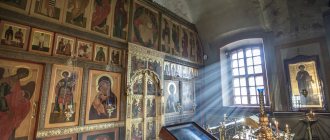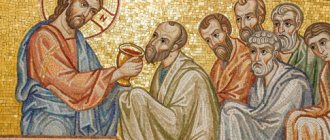What is the name of the liturgical vessel for consecrating wine and receiving communion?
CHALICE - (Greek poter).
The cup in which during the liturgy wine is mixed with water from which communion is given. Dictionary of foreign words included in the Russian language. Chudinov A.N., 1910. CHALICE (or cup) a church vessel used during liturgy and consecration... ... Dictionary of foreign words of the Russian language Chalice - noblewomen A.I. Morozova. Gold, precious stones, enamel. 1664. State museums of the Moscow Kremlin. CHALICE (Greek poter cup, goblet), liturgical vessel for consecrating wine or receiving communion, a cup on a high stem, often made of ... ... Illustrated Encyclopedic Dictionary
Chalice - (from the Greek poter bowl, goblet), a liturgical vessel for consecrating wine and receiving communion, a bowl on a high stem, often made of precious metals or ornamental stones. Chalice. Marble, gold frame. 1449. Master Ivan Fomin. Zagorsky... ...Art Encyclopedia
chalice - vessel, ostensorium Dictionary of Russian synonyms. chalice noun, number of synonyms: 3 • ostensorium (1) • vessel ... Synonym dictionary
CHALICE - (Greek poter) a liturgical vessel for consecrating wine and taking communion, a cup on a high stem, often made of precious metals or ornamental stones ... Big Encyclopedic Dictionary
CHALICE - CHALICE, chalice, husband. (Greek poter) (church). Large bowl, used. in Christian cult ritual. Ushakov's explanatory dictionary. D.N. Ushakov. 1935 1940 ... Ushakov's Explanatory Dictionary
CHALICE - male, Greek. a bowl with a tray in which, during the liturgy, the Holy Gifts are offered. Cruet. Dahl's Explanatory Dictionary. IN AND. Dahl. 1863 1866 ... Dahl's Explanatory Dictionary
Chalice - (pothr) the Greek name for the cup from which Orthodox Christians partake of the body and blood of Christ. It is used in the Eucharist following the example of I. Christ himself and the apostles (1 Cor. X, 16) and, according to the testimony of the church fathers, it was used continuously.... ... Encyclopedia of Brockhaus and Efron
The chalice is liturgical. a bowl-shaped vessel on a high leg. During the liturgy, wine is poured into the P. and particles of bread from the prosphora for communion are dropped. P. are made from semi-drugs. and drag. (gold, silver) metals, semi-drugs are decorated. and drag. stones,... ...Russian humanitarian encyclopedic dictionary
Chalice - (from the Greek poter cup, goblet) a liturgical vessel for consecrating wine (and receiving communion) in the form of a bowl on a high stem. P., known from the 2nd century. n. e., were made of gold, silver, bronze, semi-precious stones, decorated with precious... ... Great Soviet Encyclopedia
Source of the article: https://dic.academic.ru/dic.nsf/ruwiki/109987
Church vessel for taking communion
The last letter of the letter is “r”
Answer to the question “Church vessel for taking communion,” 5 letters: chalice
Alternative crossword questions for the word chalice
m. Greek a bowl with a tray in which, during the liturgy, the Holy Gifts are offered. Cruet
Precious communion cup
Communion Cup
Ancient Greek vessel for blessing wine
Symbolizes the Holy Grail
Vessel for taking communion, bowl on a high stem
Cup for blessing wine
Definition of the word chalice in dictionaries
Encyclopedic Dictionary, 1998. The meaning of the word in the dictionary Encyclopedic Dictionary, 1998. CHALICE (Greek poter) a liturgical vessel for consecrating wine and taking communion - a bowl on a high stem, often made of precious metals or ornamental stones.
Church vessel
The last letter of the letter is “r”
Answer for the question “Church vessel”, 5 letters: chalice
Alternative crossword questions for the word chalice
Vessel for blessing wine and taking communion
Vessel for taking communion, bowl on a high stem
Church high bowl
Bowl for religious ceremonies
Bowl on a high stem for red wine
Liturgical vessel for blessing wine and receiving communion
Examples of the use of the word chalice in literature.
The clergyman of the Aachen Cathedral heeded Flory's persistent arguments and Buturlin's doubloons, and when, after the prayer service, the heavy copper plaque succumbed to the efforts of the church guards, an empty coffin filled with handwritten books, ancient chalices and tabernacles, among which could be seen a greenish glass bottle, opened before those gathered.
Having put aside the ripida, the deacon raises the holy paten and the Holy Chalice - the altar is no longer the upper room of the Last Supper, the throne is no longer a meal: it is now an altar on which a terrible sacrifice is made for the whole world - Golgotha, on which the slaughter of the Divine Sacrifice took place.
Chalice, paten, star, ripid, tray, censer and incense, crosses large and small, all made of gold and silver, decorated with gems and enamel, were also included, gold embroidered banners, shrouds, silver vestments, donated by the prince, Russian lands, boyars and voivodes church ports and pavilions for the sacristy, Gospels in expensive frames, menology prayer books decorated with drawings, psalters written on the noblest calfskin, many secular books were brought in, collected by Prince Yaroslav and now donated for the temple - for the first collection of books in Rus'.
His neighbor constantly poured it into a tall inlaid glass, which must have been an ancient chalice.
If amphorae and vessels made of gold and small gilded bowls, by the will of the Lord and according to the prophecies of the prophets, were used to collect the blood of goats, calves and heifers in Solomon’s Temple, then all the more likely golden patterned chalices strewn with honest stones, along with other, the most valuable of those created by man things, are obliged to serve, with the greatest reverence and with true faith, to receive the blood of Christ!
Source: Maxim Moshkov library
Article source: https://xn--b1algemdcsb.xn--p1ai/crossword/1781527
Chalice from a church with 5 letters
[Home] P
ABOUT
T
AND
R
- P is the first letter
- O - second letter
- T - third letter
- I is the fourth letter
- P - fifth letter
Because of whom Ivan Turgenev never managed to build a “family nest” 6 letters
What sauce is served at the table 5 letters
chalice
A cup used in Christian cult rites.
chalice
(Greek poter); church A vessel for consecrating wine and taking communion in the form of a bowl on a high leg (usually made of precious metals, ornamental stones, decorated with precious stones)
bowl
I 1) An antique large feast wine vessel with a wide hemisphere-shaped top and a narrow bottom directly connected to the stand. Ott. The amount of liquid that can be held in such a container. 2) Any round-shaped vessel. Ott. The amount of liquid that can be held in such a container. 3) Something that has the shape of such a vessel (pit, reservoir, etc.). II Used as a symbol of the measure of something experienced. III Used as a symbol of fate, fate (usually difficult, unhappy).
bowl
1) a) An ancient large vessel with a wide top and narrow bottom, devoid of a leg, with a body that is directly connected to the stand; usually for drinking wine and intoxicating drinks. Fill the cup. Place the bowls on the table. b) from; traditional-poet Any vessel for wine. Clink glasses. Raise the cup of wine. Pour full bowls. this T. An amount of liquid equal to the volume of such a vessel. Drink the cup to the bottom. 2) Any vessel, a round-shaped container. Scales. Fountain bowl. Concrete mixer bowl. 3) public. About something that has the shape of such a vessel. Bowl of the pit. Reservoir bowl. Bowl of the cathedral dome. 4) book. About a large amount of something. (feelings, experiences, etc.) that befell someone. share. Drink (to the bottom) the cup of love, suffering, joy, grief (experience, experience something to the fullest) Drain the cup of suffering (experience a lot of suffering) Drink the cup of joy, pleasure (rejoice, enjoy) 5) special. = cup 4) - drink a full cup - drink a dead cup - overfill the cup - the cup is overflowing - throw it on the scales - this cup will pass
church
I A religious organization of clergy and believers with a complex hierarchical system, preserving and transmitting the fundamentals of religious doctrine, worship, and the celebration of the sacraments; God's house. II A building in which Christian worship takes place; Orthodox church.
church
-kwi; pl. - churches, churches, churches and churches; and. see also church, little church 1) A religious organization of clergy and believers, united by a community of beliefs and rituals; the religion preached by such an organization. Orthodox Church. Catholic Church. Church Fathers (interpreters of Christian doctrine) 2) The building in which Christian worship takes place. White stone church. Wooden church. Three-domed church. To get married, to perform a funeral service for smb. in the church. Go to church. (also: to be a believer) Evangelical Church. Baptist Church. Lutheran Church.
Liturgical vessel for blessing wine and receiving communion
The last letter of the letter is “r”
Answer to the question “Liturgical vessel for consecrating wine and receiving communion,” 5 letters: chalice
Alternative crossword questions for the word chalice
In what cup is church wine turned into the “blood of Christ”
A bowl with a tray in which the Holy Gifts are offered during the Liturgy
Precious communion cup
Liturgical vessel for the blessing of wine
Communion Cup
Definition of the word chalice in dictionaries
Examples of the use of the word chalice in literature.
The clergyman of the Aachen Cathedral heeded Flory's persistent arguments and Buturlin's doubloons, and when, after the prayer service, the heavy copper plaque succumbed to the efforts of the church guards, an empty coffin filled with handwritten books, ancient chalices and tabernacles, among which could be seen a greenish glass bottle, opened before those gathered.
Having put aside the ripida, the deacon raises the holy paten and the Holy Chalice - the altar is no longer the upper room of the Last Supper, the throne is no longer a meal: it is now an altar on which a terrible sacrifice is made for the whole world - Golgotha, on which the slaughter of the Divine Sacrifice took place.
Chalice, paten, star, ripid, tray, censer and incense, crosses large and small, all made of gold and silver, decorated with gems and enamel, were also included, gold embroidered banners, shrouds, silver vestments, donated by the prince, Russian lands, boyars and voivodes church ports and pavilions for the sacristy, Gospels in expensive frames, menology prayer books decorated with drawings, psalters written on the noblest calfskin, many secular books were brought in, collected by Prince Yaroslav and now donated for the temple - for the first collection of books in Rus'.
His neighbor constantly poured it into a tall inlaid glass, which must have been an ancient chalice.
If amphorae and vessels made of gold and small gilded bowls, by the will of the Lord and according to the prophecies of the prophets, were used to collect the blood of goats, calves and heifers in Solomon’s Temple, then all the more likely golden patterned chalices strewn with honest stones, along with other, the most valuable of those created by man things, are obliged to serve, with the greatest reverence and with true faith, to receive the blood of Christ!
Source: Maxim Moshkov library
Article source: https://xn--b1algemdcsb.xn--p1ai/crossword/1402811
Communion cup
The last letter is the letter “r”
Answer to the question “Communion Cup”, 5 letters: chalice
Alternative crossword questions for the word chalice
Vessel for worship
Church vessel for taking communion
m. Greek a bowl with a tray in which, during the liturgy, the Holy Gifts are offered. Cruet
Cup for blessing wine
Church high bowl
Definition of the word chalice in dictionaries
Encyclopedic Dictionary, 1998. The meaning of the word in the dictionary Encyclopedic Dictionary, 1998. CHALICE (Greek poter) a liturgical vessel for consecrating wine and taking communion - a bowl on a high stem, often made of precious metals or ornamental stones.
Examples of the use of the word chalice in literature.
The clergyman of the Aachen Cathedral heeded Flory's persistent arguments and Buturlin's doubloons, and when, after the prayer service, the heavy copper plaque succumbed to the efforts of the church guards, an empty coffin filled with handwritten books, ancient chalices and tabernacles, among which could be seen a greenish glass bottle, opened before those gathered.
Having put aside the ripida, the deacon raises the holy paten and the Holy Chalice - the altar is no longer the upper room of the Last Supper, the throne is no longer a meal: it is now an altar on which a terrible sacrifice is made for the whole world - Golgotha, on which the slaughter of the Divine Sacrifice took place.
Chalice, paten, star, ripid, tray, censer and incense, crosses large and small, all made of gold and silver, decorated with gems and enamel, were also included, gold embroidered banners, shrouds, silver vestments, donated by the prince, Russian lands, boyars and voivodes church ports and pavilions for the sacristy, Gospels in expensive frames, menology prayer books decorated with drawings, psalters written on the noblest calfskin, many secular books were brought in, collected by Prince Yaroslav and now donated for the temple - for the first collection of books in Rus'.
His neighbor constantly poured it into a tall inlaid glass, which must have been an ancient chalice.
If amphorae and vessels made of gold and small gilded bowls, by the will of the Lord and according to the prophecies of the prophets, were used to collect the blood of goats, calves and heifers in Solomon’s Temple, then all the more likely golden patterned chalices strewn with honest stones, along with other, the most valuable of those created by man things, are obliged to serve, with the greatest reverence and with true faith, to receive the blood of Christ!
Source: Maxim Moshkov library
Article source: https://xn--b1algemdcsb.xn--p1ai/crossword/1951112
Vessel for blessing wine and taking communion
The last letter of the letter is “r”
Answer to the question “Vessel for consecrating wine and taking communion,” 5 letters: chalice
Alternative crossword questions for the word chalice
Symbolizes the Holy Grail
Liturgical vessel for the blessing of wine
Vessel for the blessing of wine
Bowl on a high stem for red wine
Communion Cup
Vessel for taking communion, bowl on a high stem
Definition of the word chalice in dictionaries
Examples of the use of the word chalice in literature.
The clergyman of the Aachen Cathedral heeded Flory's persistent arguments and Buturlin's doubloons, and when, after the prayer service, the heavy copper plaque succumbed to the efforts of the church guards, an empty coffin filled with handwritten books, ancient chalices and tabernacles, among which could be seen a greenish glass bottle, opened before those gathered.
Having put aside the ripida, the deacon raises the holy paten and the Holy Chalice - the altar is no longer the upper room of the Last Supper, the throne is no longer a meal: it is now an altar on which a terrible sacrifice is made for the whole world - Golgotha, on which the slaughter of the Divine Sacrifice took place.
Chalice, paten, star, ripid, tray, censer and incense, crosses large and small, all made of gold and silver, decorated with gems and enamel, were also included, gold embroidered banners, shrouds, silver vestments, donated by the prince, Russian lands, boyars and voivodes church ports and pavilions for the sacristy, Gospels in expensive frames, menology prayer books decorated with drawings, psalters written on the noblest calfskin, many secular books were brought in, collected by Prince Yaroslav and now donated for the temple - for the first collection of books in Rus'.
His neighbor constantly poured it into a tall inlaid glass, which must have been an ancient chalice.
If amphorae and vessels made of gold and small gilded bowls, by the will of the Lord and according to the prophecies of the prophets, were used to collect the blood of goats, calves and heifers in Solomon’s Temple, then all the more likely golden patterned chalices strewn with honest stones, along with other, the most valuable of those created by man things, are obliged to serve, with the greatest reverence and with true faith, to receive the blood of Christ!
Source: Maxim Moshkov library
Article source: https://xn--b1algemdcsb.xn--p1ai/crossword/1781522
Communion vessel
The last letter is the letter “r”
Answer to the question “Vessel for taking communion”, 5 letters: chalice
Alternative crossword questions for the word chalice
Vessel for taking communion, bowl on a high stem
Bowl for religious ceremonies
Liturgical vessel for the blessing of wine
m. Greek a bowl with a tray in which, during the liturgy, the Holy Gifts are offered. Cruet
Bowl on a high stem for red wine
Definition of the word chalice in dictionaries
Encyclopedic Dictionary, 1998. The meaning of the word in the dictionary Encyclopedic Dictionary, 1998. CHALICE (Greek poter) a liturgical vessel for consecrating wine and taking communion - a bowl on a high stem, often made of precious metals or ornamental stones.
Wikipedia Meaning of the word in the Wikipedia dictionary Chalice (from, “chalice, goblet”) is a vessel for Christian worship, used for the consecration of wine and the reception of Holy Communion. As a rule, a chalice is a deep bowl with a long stem and a round base of large diameter, sometimes made of valuable materials.
Examples of the use of the word chalice in literature.
The clergyman of the Aachen Cathedral heeded Flory's persistent arguments and Buturlin's doubloons, and when, after the prayer service, the heavy copper plaque succumbed to the efforts of the church guards, an empty coffin filled with handwritten books, ancient chalices and tabernacles, among which could be seen a greenish glass bottle, opened before those gathered.
Having put aside the ripida, the deacon raises the holy paten and the Holy Chalice - the altar is no longer the upper room of the Last Supper, the throne is no longer a meal: it is now an altar on which a terrible sacrifice is made for the whole world - Golgotha, on which the slaughter of the Divine Sacrifice took place.
Chalice, paten, star, ripid, tray, censer and incense, crosses large and small, all made of gold and silver, decorated with gems and enamel, were also included, gold embroidered banners, shrouds, silver vestments, donated by the prince, Russian lands, boyars and voivodes church ports and pavilions for the sacristy, Gospels in expensive frames, menology prayer books decorated with drawings, psalters written on the noblest calfskin, many secular books were brought in, collected by Prince Yaroslav and now donated for the temple - for the first collection of books in Rus'.
The Cup of the Last Supper: sacred or mythical?
Since knightly times, it has become popular to bring relics in large quantities to Europe. Unfortunately, they began not only to be imported, but also to be falsified. And this later began to put the Church in a difficult position: popular piety demanded veneration of the shrine presented, and the episcopate avoided officially recognizing the relics as authentic. And in most cases the bishops were right.
It was at that time that a conflict arose: several bowls appeared, which were called the “Cup of the Last Supper.”
These cups became associated with the legendary Grail, which from Celtic myths migrated to the Round Table of the mythical king of the British Isle - Arthur. Later, a legend appeared that the righteous Joseph of Arimathea brought this cup, which the Savior held in His hands at the Last Supper, to the English city of Glanstonbury, where it is located at the bottom of some well. In addition, a belief arose that Joseph of Arimathea collected the blood of the Crucified One in the same cup.
There are many more legends about the Grail that can be considered. But the question about the cup of the Last Supper arose due to the fact that the cup began to be reconstructed and used as a liturgical chalice.
What did the cup of Christ look like at the last Easter Supper?
So, do we know what the cup that Christ used during the last ritual Easter Supper looked like? Of course not! Indeed, in that era, bowls already had quite a variety of shapes and were made from various materials.
The poor used mainly ceramic dishes. And for some it became a temptation to think that Christ should have had a cup made of clay in his hands, since he was a poor preacher.
But let us remember that the Savior entered the house of the man who gave them a meal in the upper room on Mount Zion.
Zion in Jerusalem was the quarter of the richest people; Jewish nobles lived there. And the Zion Upper Room is located next to the palaces of Herod the Great and the High Priest.
And in the house of a rich man, there was probably rich dishes. It could have been colored glass, or it could have been silver, so beloved by the Israelis of that time. But there could also be stoneware. Yes, yes, exactly stone. The fact is that Jews believe that truly kosher food is only in stone vessels, which only rich religious people could afford.
In some serious reconstructions of the Last Supper, with the participation of authoritative archaeologists, it was assumed that the wine jug was made of stone, and the ritual cup was deep silver, on a low round stand. At the same time, it is not at all necessary that the bread be placed on some kind of tray - most likely, it lay in a stack right on the table among other ritual dishes for the Easter meal.
What were the liturgical vessels like during the time of the first Christians?
We have a very vague idea of what kind of vessels the Eucharistic offerings were made on during the Supper of Love by the first Christians, but on the catacomb frescoes there is an image of dishes similar to earthenware. It is difficult today to guess whether there are liturgical vessels in these images of sacred symposiums.
Agape. Rome. Catacombs of Domitilla. III century
In fact, the established name of the Eucharistic cup “chalice” tells us not so much about the cup as about the object for drinking. This is exactly how this word is accurately translated from ancient Greek. And therefore it allows for any deep form from which one can drink.
However, historians do not rule out that even in catacomb times, Christians used vessels made of precious metals or made from stones revered by the Romans (onyx, agate, alabaster, porphyry and marble) to serve the Eucharist.
We can say that by the 4th century. The shape of the liturgical cup had already taken shape and became popular: a cup with a high stem. Since the time of the early Christian meetings, the paten (plate) for the Breaking of Bread began to be used. Apparently, it was also made from expensive materials, just like the bowl.
These were sacred objects that were bought together and could serve more than one generation of Christians. They were often hunted by informers during periods of persecution of the followers of the Nazarene - as the only reliable treasure of the community.
Christians have given little thought to the Last Supper as a historical event. They had no need to reconstruct what happened in time. Christ and His Eucharist were always for them a modern event in which they participated - not just in memory, but in anticipation of a genuine meeting with the Teacher. Therefore, what was truly dear to Christians was not the vessels, but their contents: the Body and Blood of Christ. They did not wonder about historical truth, but experienced the joy of real Communion at the Last Supper.
What Eucharistic vessels and patenes were used after the edict of King Constantine?
Eucharistic cup. Late 5th century
After the edict of Constantine the Great, which allowed Christians to be on an equal footing with pagans, Christian communities began to openly worship and build their churches. Liturgical life began to take shape, and with it liturgical objects. Provincial prefects and the emperor himself generously gave expensive Eucharistic vessels to the churches. This was reflected in the Life of St. Nicholas of Myra.
The bowls had the appearance of imperial goblets and were often conical in shape. The discos resembled ordinary plates. This was understandable, since they almost always bought ordinary bowls and plates from jewelers, which could be used by rich people during feasts.
With the increase in the flock in the province, the custom of receiving Holy Communion from the Eucharistic jug began to appear.
Eucharistic jug. 8th century
Liturgical scholars believe that jugs began to be used due to the lack of bowls in poor communities. And the wine that Christians brought in jugs, in jugs, as the fullness of the offering, was used during the Eucharistic service.
Later, such a jug began to be made either from skillfully crafted semi-precious stones depicting Christian symbols, or from precious metals, less often - from copper gilded through fire. This tradition became popular in monasteries, since often after the Liturgy the deacon carried Communion to hermits, and the jug turned out to be a very practical item for this, while the sacred Bread was simply wrapped in clean cloth.
It must be noted that according to tradition, almost until the 10th century, the faithful drank the Blood of Christ directly from the liturgical cup or from the mentioned jug. Whereas the Most Pure Body was given into their hands, and later into plates on their hands, and they independently accepted it with reverence, first touching their eyes and foreheads, and then consuming it internally.
In the Eastern Churches, from the 7th century, the tradition of giving communion from a spoon began to spread. However, only the Blood of Christ was served in a spoon (this custom is now preserved among the Copts). Since the 10th century, they began to immerse the Bread in a cup with Blood and serve the saturated parts of the Body with a spoon.
Catholics, in disputes with Orthodox Christians, criticized the dipping of consecrated bread into the cup. Cardinal Humbert, in his treatise Against Greek Abuses, wrote: “Jesus did not put bread in a cup and did not say to the apostles: “Take and eat with a spoon, this is my body.” The Lord did not offer the dipped bread to any of the disciples except Judas the traitor, to show who would betray him.” Those. Latins began to get carried away by the historicism of the event of the Last Supper.
When and why did the tradition of giving communion with a spoon arise?
The tradition of taking communion with a spoon, apparently, was not associated with the emergence of any new ideas about personal hygiene. On the contrary: this was how the development of a more respectful attitude towards the Eucharist manifested itself and created convenience with a large influx of people wishing to receive Communion. After all, now there was no longer a need to come up twice for Communion, but everything was served once in full.
In addition, in contrast to the Latin tradition, which focused attention on the suffering and death of Christ, and therefore during Communion, unleavened bread was served, i.e. the bread of sorrow, the symbol of the dead Body, the Eastern Church formed its attitude towards the substances of the Liturgy through theology. For the Churches of the East, the Liturgy became the phenomenon of the Easter Resurrection, and the liturgical bread was “living” - leavened, the bread of joy. It is logical that with such a theology, the Body should be visibly united with the Blood for the faithful as a sign of the restoration of life - the Resurrection. Therefore, the Body began to be immersed in the Chalice and served from there with a spoon.
The spoon for Communion itself was called not “spoon”, “cochlear”, but “labuda”, “pincers” - as a reminder of the hot coal that was put into the mouth of the prophet Isaiah with tongs (Is. 6:7).
It is interesting that the first forms of such spoons resembled real spoons, quite large in size. Until the 18th century, even when the spoons became smaller, they remained deep enough to serve enough Wine and Bread for the communicants.
In the middle of the 12th century, when the custom was still considered an innovation, along with the spoon, another tradition began to appear: drinking from the Chalice using a special silver straw. This custom spread especially quickly in Africa and Spain. But it did not catch on and such tubes became museum rarities already in the 14th century.
I have come across the opinion that such sacramental tubes appeared much earlier and suggest that they could have existed even in the 6th century. Particularly in the Western Church.
Few people know, but in the 4th century a wine strainer was also considered a liturgical object. It was also made from silver or other valuable material and was used to pour wine into the Eucharistic cup.
Treasure of the Zion Monastery: chalices, censers, tabernacle, in the foreground a wine strainer
The fact is that before the Liturgy, Christians brought both their own wine and the bread they had baked. And the wine was often not of the highest quality, and therefore purity. Therefore, a strainer was necessary so that the wine in the bowl would be cleared of impurities.
Along with the cup, a jug was used for the Eucharistic service until the 14th century, and the fresco of the Eucharist in the Athos monastery of Stavronikita makes us understand that in the 16th century on Athos a jug could have been used for Communion.
Thus, the spoon was not at all a ubiquitous object, and the use of the jug suggests communion under two types: Bread and Wine separately.
Russian Orthodox Church
An article by the Chairman of the Department for External Church Relations, Metropolitan Hilarion of Volokolamsk, published in the Journal of the Moscow Patriarchate (No. 9, September 2011), is devoted to an analysis of the practice of celebrating the Divine Liturgy using a large cup.
At the end of the 20th century, a most important change occurred in the liturgical practice of the Russian Orthodox Church: almost everywhere, much more frequent communion of the laity was established than was previously customary.
Most laity and even clergy, especially those who came to the Church in the last twenty years ago, no longer remember that not so long ago the norm was considered to be communion several times a year: once or twice during Lent (usually during the first and Holy weeks ) and once or twice during the rest of the year (usually on the day of the angel; sometimes also on the Nativity or Dormition fasts). This was the practice of the pre-revolutionary Russian Church, reflected in the “Catechism” of St. Philaret of Moscow: “Ancient Christians received communion every Sunday; but few of today have such purity of life as to always be ready to begin such a great Sacrament. The Church, with a maternal voice, commands those who are zealous for a reverent life to confess to their spiritual father and partake of the Body and Blood of Christ - four times a year or every month, and for everyone - certainly once a year” (1). Nowadays, receiving communion once a month, which St. Philaret speaks of as a special feat of “the few,” has actually become the norm for churchgoers, and many of them begin holy communion on every holiday and Sunday.
Another important change is the significant increase in the number of cathedral services. After many years of persecution, the Church gained freedom, and this led to a sharp increase in the number of clergy and, consequently, an increase in the number of communicants in holy orders at cathedral services.
This article is not devoted to an assessment of these phenomena in general, but to an analysis of one of their particular consequences, namely the practice of celebrating the Divine Liturgy using a large cup.
Nowadays, at the bishop's Liturgy, especially when there is a large crowd of worshipers, a chalice (chalice) of a very impressive size is often used during the service, almost half a man's height and a volume of three, five, or even nine liters. Eucharistic cups with a capacity of over a liter are also used in parish services - especially in multi-state parishes on major holidays. When using multi-liter bowls during proskomedia, as a rule, only part of the wine and water prepared for the consecration is poured into the chalice, and the main volume is added after the great entrance, since it is not easy to carry a multi-kilogram vessel at the great entrance. Then, at the end of the Eucharistic prayer and at the cry of “Holy to Holies,” the most pure Blood of Christ is poured from a large chalice into bowls of regular size, that is, with a volume of 0.5-0.75 liters. Thus, the main volume of Eucharistic wine - and then the Holy Blood - is in the main chalice not during the entire Liturgy, but only during its “sanctifying” part, from the Great Entrance to the Communion of the clergy.
According to many clergy, the situation of a crowded service with a large number of communicants does not provide for any other way out than using a huge cup, adding wine into it and then pouring the Holy Blood from it into several cups. And to the question of whether it is possible to place on the altar not one huge bowl, but several bowls of regular size, before the consecration of the Holy Gifts, the answer is: it is not possible. At the same time, they also cite a “theological” argument: after all, we all partake of “one bread and one cup,” how can you put several cups on the throne? This, they say, violates the Eucharistic symbolism.
What did the tradition of the Ancient Church prescribe in a similar situation, in which the simultaneous communion of many communicants in huge churches (remember the basilicas built by St. Emperor Constantine the Great or the Constantinople Church of Hagia Sophia of the Wisdom of God) was by no means uncommon?
Of particular importance among ancient church testimonies are data on worship in Constantinople and Byzantium in general, since our liturgical tradition is the heir and direct continuation of the Byzantine one. Archaeological evidence suggests that even the largest Byzantine chalice did not exceed a volume of 0.75-1 liter (2). Obviously, one such bowl for worship in the Church of Hagia Sophia would clearly not be enough. What did the Byzantines do? Patristic and liturgical sources give a clear answer: they celebrated the Eucharist simultaneously on many vessels (3). By the way, there could have been several paten with Lambs lying on them.
For the first time, many chalices during the Divine Liturgy are mentioned in the “Apostolic Constitutions” (VIII. 12. 3) - a collection of early Christian documents, finally edited around 380 in Antioch (4). In relation to Constantinople, the “Easter Chronicle” of the 7th century testifies to the multitude of paten and bowls in the rite of the Divine Liturgy (5). These data are confirmed by St. Maximus the Confessor, who additionally gives a symbolic interpretation of why there must be an odd number of cups at the Liturgy (6). In a whole series of Byzantine collections of liturgical texts, starting with the Barberine Euchologia, the oldest surviving manuscript of the Byzantine Service Book and Trebnik (Vat. Barb. gr. 336, end of the 8th century), and especially in the lists intended for bishop’s services, in the rubrics of the rite of the Divine Liturgy, it is said not about the “cup”, but about “chalices” (7). Indications of many cups during the Liturgy are contained in the Byzantine order of the Patriarchal and Bishops' Liturgy of the 14th century, compiled by Demetrius Gemistos (8). Finally, the iconography of the great entrance in Byzantine and Balkan frescoes of the 14th-16th centuries also represents many bowls.
In addition to the simple mention of many cups in the Liturgy, some Byzantine sources also contain statutory instructions on how the Eucharist should be celebrated if there are several cups. Saint Simeon of Thessalonica writes that the words of the proskomedia do not change, “even if there are many cups” (9). The rite of the Liturgy described by Demetrius Gemistos says that at the great entrance the Patriarch places the paten on the throne, and places the bowls in pairs on both sides of the paten (10). In a letter from the Patriarch of Constantinople Nicholas III Grammar (11) written at the end of the 11th century to Bishop Paul of Gallipoli, it is said in detail that the paten is placed in the shape of a cross, and the bowls are placed between the shoulders of this cross.
So, the celebration of the Divine Liturgy on many chalices and many paten is not just some kind of incident, but a completely ordinary Byzantine practice, which, moreover, was even normative during the bishop’s service. Why did it disappear in the post-Byzantine era? Obviously, its disappearance is associated with the establishment of the practice of rare communion and the general tendency to reduce the size of churches (12). In small churches with a few communicants, the need to use significant volumes of Eucharistic wine disappeared - and along with it, the need to celebrate the Liturgy in many vessels also disappeared.
At the same time, for some time the practice of making the great entrance with the transfer of many cups in the procession was still preserved - but the cups, except for one main cup with wine, began to be carried empty. Already Saint Simeon of Thessaloniki describes such a practice and, moreover, gives an explanation for it, arguing that the transfer of empty cups at the great entrance occurs “as a sign of veneration of the honest Gifts” (13). A similar practice was known in pre-Nikon Rus': in the services of the largest ancient Russian cathedrals on holidays, not only the paten and the cup with Eucharistic bread and wine, but also other empty vessels, including sion, that is, tabernacles, were transferred to the great entrance (14). The custom of transferring during the great entrance, in addition to the paten and the chalice, also the tabernacle, is preserved to this day in the Russian Church in the rank of Patriarchal enthronement (15).
Returning to the modern church situation, we can pose the question: what prevents us today from returning to the Byzantine practice of celebrating the Liturgy with many cups? To answer this question, one should evaluate the positive and negative aspects of celebrating the Liturgy on one multi-liter chalice. The first positive side is that one large cup visually symbolizes the unity of the Church in the Eucharist and, as it were, illustrates the words from the anaphora of St. Basil the Great: “But unite us all, from the one Bread and Chalice of communion, with each other into the one Holy Spirit.” The second positive side is the solemnity and grandeur that can be seen in the celebration of the Liturgy on huge vessels.
But the same arguments can be turned in the other direction. Firstly, to some, unnaturally large paten and bowl may seem grotesque and unaesthetic. Secondly, even when using a huge chalice, the Holy Blood from it is still ultimately poured into many cups, from which believers receive communion: therefore, by the time of communion, one way or another, there is already not one cup, but many cups on the throne. In addition, when serving on one huge chalice, the liturgical symbolism is also violated, only in a different way. After all, wine is necessarily added to the chalice after the Great Entrance, but this added wine, unlike the one already in the chalice, was not poured at the proskomedia with the utterance of the prescribed words and did not participate in the procession of the Great Entrance. And this procession is also loaded with various symbolism.
Moreover, the very argument for the “single cup” as supposedly symbolizing the unity of the Eucharist can be contested. Firstly, the Byzantines knew the words of their own anaphora very well, which did not prevent them from celebrating the Liturgy with many cups. Secondly, and this is the main thing, in the anaphora of Basil the Great we are not talking about the cup at this or that specific Liturgy, but about the Cup of Christ as such - about the Cup of His most pure Blood shed for the whole world. This Chalice is the same in all churches around the world, no matter how many chalices there are on the throne. Just as many chalices in many churches are one and the same Chalice of Christ, so many bowls standing on the throne of one temple during the Divine Liturgy are one and the same Chalice.
However, we were prompted to write this article not by considerations of a theological or church-historical nature, but by practical ones. They are associated primarily with the need, when serving on one large chalice, to pour the Holy Blood from it into ordinary smaller chalices. The very volume of such a chalice greatly complicates any manipulation with it - and even more so when it concerns the Holy Blood, not a single drop of which should be lost during the process of pouring into the cups. The author of these lines has repeatedly had to witness very regrettable scenes: when, pouring the Holy Blood from a huge chalice, the priest spilled significant volumes of it on the antimension, the altar, his own vestments, even on the floor. Indeed, sometimes the chalice is so large that the priest, standing at the altar, does not even see its contents and pours the Holy Blood “by touch.” Visual evidence of such scenes are the antimensions filled with Holy Blood that lie on the altars of many of our churches.
Another practical difficulty is associated with the consumption of the Holy Gifts remaining after communion, since when using a large chalice it can be difficult to correctly determine in advance the required amount of Eucharistic wine, and washing out a large chalice is not always an easy task. Finally, the use of large chalices is not sufficiently justified economically - for example, in parishes, episcopal and crowded holiday services do not happen very often, but for the sake of them, parish communities have to spend a lot of money on purchasing expensive large chalices, which are then used only occasionally.
In our opinion, the described difficulties when using multi-liter chalice should make us remember the Byzantine practice of celebrating the Divine Liturgy on many bowls of regular sizes, repeatedly and unequivocally attested in a number of sources. In accordance with this practice, several cups should be placed on the throne not after the consecration of the Holy Gifts, but before their consecration - so that by the time the wine is transmuted into the Blood of Christ, all the cups will be on the throne, from which the believers will then receive communion. At the same time, if we are literally guided by the Byzantine tradition, then we should place the required number of bowls on the altar already at the proskomedia, and then take them all to the great entrance. It is possible, however, to propose a less radical, but more practical option: cups of wine are placed on the throne next to the main cup after the great entrance, for example, at the beginning of the singing of the Creed. In both cases, the risk of shedding the Holy Blood when pouring it from one cup into many will disappear. There will also be no need for huge chalices, the use of which during the Liturgy gives rise to so many practical inconveniences.
Notes
- Long Orthodox Catechism of the Orthodox Catholic Eastern Church (any edition). Part 1. § 340.
- Taft R. F. The Communion, Thanksgiving, and Concluding Rites. R., 2008. (A History of the Liturgy of St. John Chrysostom; Vol. 6). (Orientalia Christiana Periodica; 281). P. 256-257.
- Taft RF The Great Entrance: A History of the Transfer of Gifts and Other Preanaphoral Rites of the Liturgy of St. John Chrysostom. R., 1978. (A History of the Liturgy of St. John Chrysostom; Vol. 2). (Orientalia Christiana Periodica; 200). P. 208-213.
- S.C. 336. P. 178.
- PG. 92. Col. 1001.
- PG. 90. Col. 820.
- Taft R. F. The Precommunion Rites. R., 2000. (A History of the Liturgy of St. John Chrysostom; Vol. 5). (Orientalia Christiana Periodica; 261). P. 366.
- Dmitrievsky A.A. Description of liturgical manuscripts stored in libraries of the Orthodox East. T. 2. K., 1901. P. 310.
- PG. 155. Col. 288.
- Dmitrievsky A.A. Description... T. 2. P. 206.
- Perhaps the author of the letter was not Nicholas III the Grammar, but one of the other two Patriarchs of Constantinople at that time - Cosmas I or Eustratius (Taft RF The Precommunion... P. 367-368).
- This trend was caused both by external circumstances - the decline and then fall of Byzantium (and in Rus' - the Tatar-Mongol yoke), and by internal processes: in late Byzantine times, the construction of a series of small temples began to be considered preferable to the construction of one large one.
- PG. 155. Col. 728.
- Golubtsov A.P. Cathedral Officials and features of service for them. M., 1907. pp. 217-220.
- Zheltov M., priest. Enthronement // Orthodox Encyclopedia. M., 2010. T. 23. P. 124-131.
“Church Bulletin” / Patriarchy.ru
About breaking and cutting Bread, or Why did the knife appear?
The knife has been used for cutting and separating bread for quite some time. In Constantinople it was used already from the beginning of the 8th century. Until this time, Bread was only broken. Therefore, when baking, it was deeply cut on top in a cross shape, so that later it would be convenient to break it into the original four parts.
And since Proskomedia (Protesis) took shape quite late, the knife (spear) began to be used there immediately with the custom of using the prosphora not completely, but to cut out the Lamb from the inside. The oldest mention of the antidoron, and therefore the cutting of the Lamb from round bread, can be considered the evidence of the “Explanation on the Liturgy” of Herman of Constantinople according to the list of the 11th century.
On the Ohrid fresco of the 11th century in St. Sophia Cathedral, in the scene of the service of St. Basil the Great, one can see that there is still round bread on the paten. But on the mosaic of the Kiev St. Sophia Cathedral, the image of a knife in the scene of the Eucharist at the holy meal is clearly visible!
Eucharist. Mosaic of Sophia of Kyiv. 11th century
And on the mosaic of the Eucharist of St. Michael's Golden-Domed Monastery (12th century) we can see a knife, a spoon, and an asterisk. However, the star is also visible on the Kiev-Sofia mosaic.
On the fresco of the St. Cyril Church in Kyiv (13th century), a brush for sweeping crumbs from the meal and paten is also noticeable in the Eucharist.
Since the star is mentioned, it should be noted that this liturgical object was definitely known in the 5th century and was discovered in the treasure of the Zion Monastery (6th century) with other vessels. It is interesting that the star was then often attached directly to the paten and made permanent.










